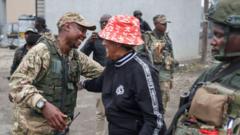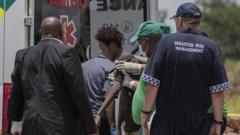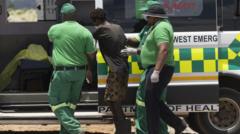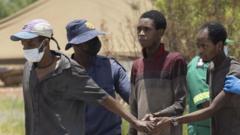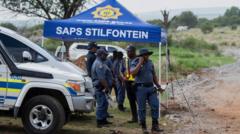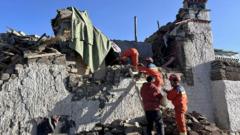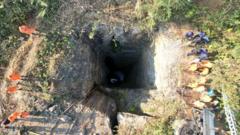**Description: Volunteers rescue miners stranded in disused gold mine, revealing shocking truths of survival amid dire conditions.**
### Tragedy Beneath the Surface: Miners' Harrowing Ordeal in South African Gold Mine
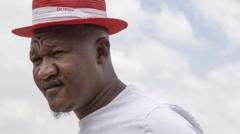
### Tragedy Beneath the Surface: Miners' Harrowing Ordeal in South African Gold Mine
**Title: Harrowing Survival Stories from South Africa's Abandoned Mines**
**Summary: As volunteers descend into a South African gold mine, they uncover disturbing evidence of survival methods employed by trapped miners, leading to debates on the government's responsibility in the tragedy.**
---
As the sun began to set over Khuma in South Africa, a group of brave volunteers descended into an abandoned gold mine, hoping to rescue trapped miners. The scent of decay hit them as they took the perilous trip down the 2km shaft, where they discovered not only the tragedy of lost lives but also harrowing testimonies of survival.
Mzwandile Mkwayi, a former convict also known as Shasha, was among those who volunteered. When he reached the depths of the mine, he encountered the shocking reality: over 70 bodies and around 200 miners in desperate need of help. In a somber reflection, he recounted how some miners had resorted to cannibalism and eating cockroaches to survive the ordeal.
"This is not just about illegal mining, but a desperate fight for survival," Mkwayi explained, revealing that many trapped miners could not escape for fear of arrest. The South African police had launched a crackdown on illicit mining in late 2023, dubbed Operation Vala Umgodi, which effectively sealed off access to food and water supplies, leading to severe consequences.
Once Mkwayi and his friend Mandla Charles were lowered into the mine, the reality of what they saw overwhelmed them. The few surviving miners, weak and emaciated, greeted them with much-needed hope. “They were incredibly grateful,” Mkwayi told reporters. But the images of despair will haunt him forever.
Following a brief rescue operation, only three days in duration, all miners were brought to the surface, and it was tragically revealed that 87 had perished underground. As volunteers and community members pressed the government for answers, accusations of responsibility began to surface. Activists labeled the deaths as a "massacre" resulting from the severe police measures.
The illicit mining struggle illustrates the broader context of economic desperation faced by many South Africans. With high unemployment rates pushing individuals to resort to illegal activities, experts advocate for government measures to regulate and provide legal opportunities for artisanal miners.
Amid calls for accountability from community leaders and unions, the government has maintained that the illegal mining operations are harmful to society, reiterating their commitment to eradicating such practices.
In the wake of this disaster, Mkwayi continues to advocate for the plight of the miners and the communities affected, emphasizing that when hunger strikes, individuals often risk everything to answer the call for survival. His words serve as a haunting reminder of the lives lost beneath the surface of a country struggling with economic decline and societal challenges.
As the dust settles on this tragedy, the dialogue surrounding the treatment of miners and the policies governing abandoned mines continues, reflecting the urgent need for solutions that address both safety and economic opportunity in South Africa.
---
As the sun began to set over Khuma in South Africa, a group of brave volunteers descended into an abandoned gold mine, hoping to rescue trapped miners. The scent of decay hit them as they took the perilous trip down the 2km shaft, where they discovered not only the tragedy of lost lives but also harrowing testimonies of survival.
Mzwandile Mkwayi, a former convict also known as Shasha, was among those who volunteered. When he reached the depths of the mine, he encountered the shocking reality: over 70 bodies and around 200 miners in desperate need of help. In a somber reflection, he recounted how some miners had resorted to cannibalism and eating cockroaches to survive the ordeal.
"This is not just about illegal mining, but a desperate fight for survival," Mkwayi explained, revealing that many trapped miners could not escape for fear of arrest. The South African police had launched a crackdown on illicit mining in late 2023, dubbed Operation Vala Umgodi, which effectively sealed off access to food and water supplies, leading to severe consequences.
Once Mkwayi and his friend Mandla Charles were lowered into the mine, the reality of what they saw overwhelmed them. The few surviving miners, weak and emaciated, greeted them with much-needed hope. “They were incredibly grateful,” Mkwayi told reporters. But the images of despair will haunt him forever.
Following a brief rescue operation, only three days in duration, all miners were brought to the surface, and it was tragically revealed that 87 had perished underground. As volunteers and community members pressed the government for answers, accusations of responsibility began to surface. Activists labeled the deaths as a "massacre" resulting from the severe police measures.
The illicit mining struggle illustrates the broader context of economic desperation faced by many South Africans. With high unemployment rates pushing individuals to resort to illegal activities, experts advocate for government measures to regulate and provide legal opportunities for artisanal miners.
Amid calls for accountability from community leaders and unions, the government has maintained that the illegal mining operations are harmful to society, reiterating their commitment to eradicating such practices.
In the wake of this disaster, Mkwayi continues to advocate for the plight of the miners and the communities affected, emphasizing that when hunger strikes, individuals often risk everything to answer the call for survival. His words serve as a haunting reminder of the lives lost beneath the surface of a country struggling with economic decline and societal challenges.
As the dust settles on this tragedy, the dialogue surrounding the treatment of miners and the policies governing abandoned mines continues, reflecting the urgent need for solutions that address both safety and economic opportunity in South Africa.




